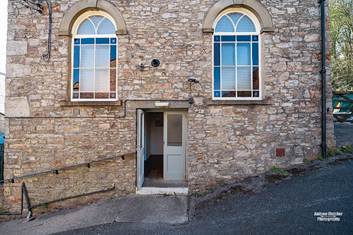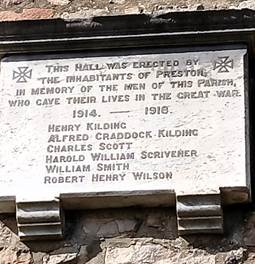The Village Hall or The Wesleyan/Methodist Chapel of Preston Under Scar

In 1983, the conversion of The Wesleyan/Methodist Chapel to a Village Hall began, under a committee comprising Mr Patrick Earle (Chairman), Mr John Fawcett (Chairman of the Parish Council), Mr Frank Torode, Miss Barbara Peacock (Treasurer), Mrs Julia McGregor (Secretary), Mrs Doreen Moore and Mr John Moore.
The building was opened officially as a Village Hall by Lord and Lady Bolton on 28th May 1984.
It has seen a variety of activities which has, and does, enrich the life of the villagers. These include coffee mornings, soup and pud, afternoon teas alongside celebrating significant moments in the year or in history. It is also used for other activities such as Preston Ladies Group Talks, craft afternoons and is the meeting place of the Parish Council. The Hall is available for hire by getting in touch with the Village Hall via email: [email protected] .
Crazy but true: For those with eagle eyes you will have noted the memorial on the side of the Village Hall .

It just doesn’t add up – here is the reason why: the Wesleyan/Methodist Chapel was not the first Village Hall in the village but the second. The dwellings now known as The Cosh, Middehus and Neigarth, towards the East of the village, combined together is the original Memorial Hall erected in 1928 in memory of the men of the Parish who died in the Great War. In the 1960’s, as the village looked to be in decline, suggestions were made in favour of turning it into a Youth Hostel, this idea was dropped. As it became increasingly in need of repairs applications to convert it into one and finally three dwellings were accepted. The Methodist Chapel, surplus to requirements became the Village Hall. It makes sense now!
History of the Wesleyan/Methodist Chapel (1805 – 1982)
Prior to the building of this Chapel in 1805, the villagers had held licensed meetings for worship in their own homes, for example, that of Mrs Elizabeth Lunn. Her fellow Wesleyans at this early period of nonconformist zeal – the mid 18th century – included John Hammond, Margaret Bearpark, Matthew Jackson and Leonard Spence. By 1795, twenty-one people in Preston were Methodists, with Leonard Spence their leader. This Preston society, until 1901 in the Middleham Circuit, included representatives, apart from those above, from the Holmes, Barningham, Carter, Mitchel, Burnett, Canby, Peacock and Spencer families.
In 1805, the Chapel at Preston was only the fourth to be built in the Dales, earlier ones being at Reeth (1796), Aysgarth (1799) and Bainbridge (1803).
An indenture of 1812 records the transfer of the Chapel premises (for one guinea) from one John Hammond to a group of Trustees, among them Anthony Bearpark, the local preacher. They agreed to preach no other doctrines than those contained in Mr Wesley’s notes upon the New Testament and the four books of sermons that he had published.
By this time, there was a weekly Sunday afternoon meeting, and by 1865 the Preston society was the largest in the Circuit, with special missions held every other year. Apart from enthusiasm for temperance, there was an emphasis on work with children and young people: Thomas Siddall, the Sunday School Teacher, class leader, and local preacher, recorded in 1859 a regular attendance of forty children.
As Trustees died, or moved, others were appointed: the Siddalls, Horns and Dents of Preston among them (between 1847 and 1907). Other long-serving, more recent Trustees included Mr Marmaduke Iveson, Mrs Alice Burnett, Mr Thomas Cradock and Mr Harry Hutchinson. The latter was one of the Trustees appointed in 1964 (the others from Preston being Mrs Hutchinson, Miss Maggie Willis, Mr J.C.F. Heseltine, Mr John Heseltine and Mrs Nora Burnett) who sold the Chapel in 1982, the village population having declined to 128.